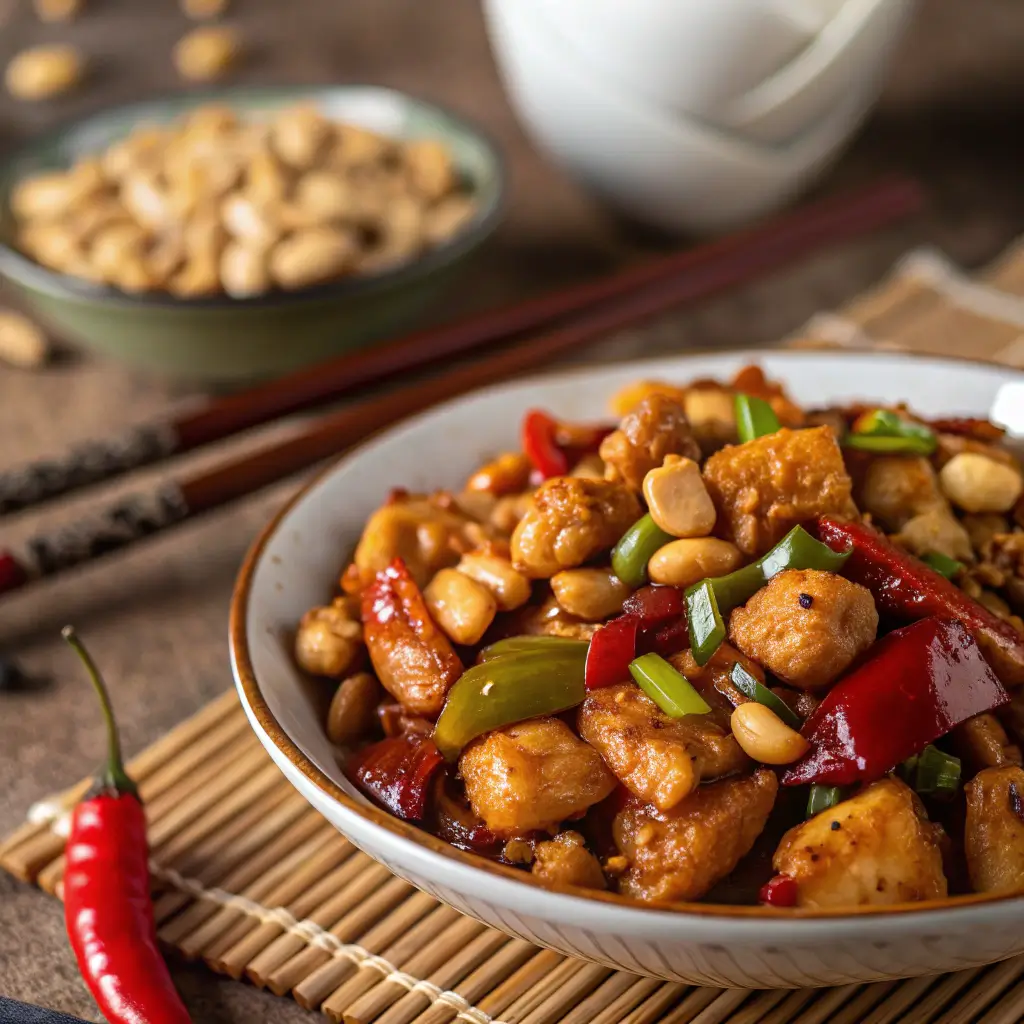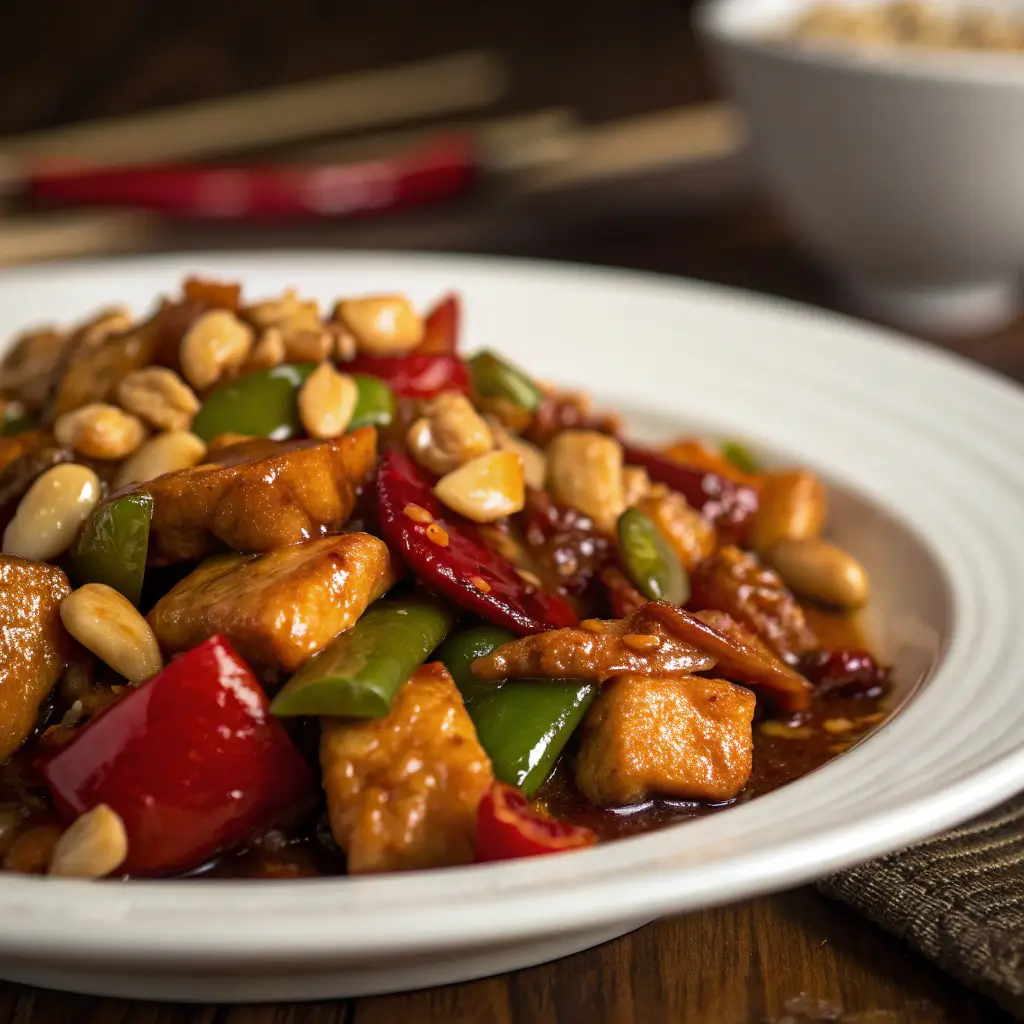Kung Pao Chicken Recipe
Introduction
Kung Pao Chicken is one of the most famous dishes in Chinese cuisine, originating from the Sichuan province. Known for its perfect balance of spicy, savory, sweet, and nutty flavors, this stir-fry has gained global popularity for its bold taste and satisfying texture. Unlike many other stir-fries, Kung Pao Chicken stands out with its fiery chili peppers, roasted peanuts, tender chicken bites, and signature sauce that clings beautifully to every ingredient.
This dish is quick to prepare, cooks in less than 30 minutes, and can be customized to suit your spice tolerance. Whether you’re craving a takeout favorite at home or looking to explore authentic Chinese flavors, Kung Pao Chicken delivers a restaurant-quality experience straight from your own kitchen.

Why You’ll Love This Recipe
- Authentic Flavor: Combines Sichuan peppercorns, dried chili peppers, and a savory-sweet sauce for a true taste of China.
- Quick & Easy: Ready in under 30 minutes, making it perfect for weeknights.
- Balanced Dish: The mix of protein, vegetables, and peanuts makes it hearty yet well-rounded.
- Customizable Heat: Adjust the amount of chili peppers or peppercorns to suit your spice preference.
- Better Than Takeout: Fresh, flavorful, and without unnecessary additives.
Ingredients
For 4 servings:
For the Chicken Marinade:
- 1 pound boneless, skinless chicken breast or thighs, cut into bite-sized cubes
- tablespoon soy sauce
- teaspoon cornstarch
- teaspoon sesame oil
For the Sauce:
- 1 tablespoon hoisin sauce
- 1 tablespoon oyster sauce
- 3 tablespoons soy sauce
- 1 tablespoon rice vinegar
- 1 tablespoon sugar (or honey)
- 2 teaspoons cornstarch mixed with 2 tablespoons water (slurry)
For the Stir-Fry:
- 2 tablespoons vegetable or peanut oil
- 6–8 dried red chili peppers, whole (adjust for spice level)
- 1 teaspoon Sichuan peppercorns (optional but traditional)
- 1 tablespoon fresh ginger, finely chopped
- 3 garlic cloves, minced
- 1 red bell pepper, diced
- 1 green bell pepper, diced
- ½ cup roasted unsalted peanuts
- 3 green onions, sliced into 1-inch pieces
Step-by-Step Instructions
Step 1: Marinate the Chicken
- In a bowl, combine chicken, soy sauce, cornstarch, and sesame oil.
- Toss until coated and let it sit for 15 minutes. This keeps the chicken juicy and helps it brown nicely during cooking.
Step 2: Mix the Sauce
- In another small bowl, whisk together soy sauce, hoisin sauce, oyster sauce, rice vinegar, and sugar.
- Set aside until ready to use.
Step 3: Stir-Fry the Aromatics
- Heat oil in a large wok or skillet over medium-high heat.
- Add dried chili peppers and Sichuan peppercorns. Stir-fry for about 30 seconds until fragrant, being careful not to burn them.
- Add garlic and ginger, stir quickly to release aroma.
Step 4: Cook the Chicken
- Increase the heat to high and add marinated chicken to the wok.
- Stir-fry until browned on all sides and nearly cooked through, about 4–5 minutes.
Step 5: Add Vegetables and Sauce
- Add bell peppers and green onions, stir-frying for 2–3 minutes until slightly tender but still crisp.
- Pour in the prepared sauce, then stir in the cornstarch slurry.
- Toss everything until the chicken and vegetables are well coated, and the sauce thickens into a glossy glaze.
Step 6: Finish with Peanuts
- Stir in roasted peanuts just before serving to maintain their crunch.
Step 7: Serve
- Transfer Kung Pao Chicken to a serving dish.
- Garnish with extra green onions or sesame seeds if desired.
- Serve hot with steamed white rice or fried rice.
Flavor Profile of Kung Pao Chicken
What makes Kung Pao Chicken special is its flavor balance:
- Spicy: From dried chili peppers and Sichuan peppercorns.
- Savory: From soy sauce and oyster sauce.
- Sweet: A touch of sugar balances the heat.
- Nutty: Crunchy peanuts add texture and richness.
- Tangy: Rice vinegar brightens the dish.
This harmony of flavors ensures that every bite is layered, exciting, and memorable.
Variations
- Protein Swap: Use shrimp, beef, tofu, or even cauliflower instead of chicken.
- Nut-Free: Replace peanuts with cashews or sunflower seeds, or omit entirely.
- Vegetable Boost: Add mushrooms, zucchini, or snap peas for extra crunch.
- Milder Version: Use fewer dried chilies or skip Sichuan peppercorns if you prefer less heat.
- Healthier Twist: Reduce oil, use low-sodium soy sauce, and serve with brown rice or cauliflower rice.
Serving Suggestions
Kung Pao Chicken pairs beautifully with:
- Steamed Jasmine Rice – absorbs the rich sauce.
- Fried Rice – for a heartier meal.
- Stir-Fried Vegetables – bok choy, broccoli, or snow peas.
- Spring Rolls or Dumplings – as appetizers for an Asian-inspired feast.
Make-Ahead and Storage
- Refrigerate: Store leftovers in an airtight container in the fridge for up to 3 days.
- Reheat: Warm in a skillet over medium heat, adding a splash of water to loosen the sauce.
- Freeze: Not recommended with peanuts, but you can freeze the chicken and sauce base for up to 2 months. Add fresh peanuts when serving.
Nutrition (Per Serving, approx.)
- Calories: 410
- Protein: 28g
- Fat: 24g
- Carbohydrates: 22g
- Fiber: 3g
- Sodium: 890mg
Values may vary depending on ingredients and serving size.

Tips for Success
- Use high heat: Stir-frying at high heat gives the chicken a slight sear and keeps vegetables crisp.
- Don’t burn the chilies: Toast them just enough to release aroma.
- Add peanuts last: Keeps them crunchy instead of soggy.
- Prep before cooking: Have all ingredients chopped and ready—stir-frying moves fast.
- Balance flavors: Taste the sauce before adding; adjust sugar, vinegar, or soy sauce to your liking.
Frequently Asked Questions
Is Kung Pao Chicken always spicy?
Traditionally yes, but you can reduce or omit dried chilies for a milder version.
What’s the difference between Kung Pao Chicken and General Tso’s Chicken?
Kung Pao is stir-fried with peanuts, vegetables, and spicy-salty flavors, while General Tso’s is deep-fried and coated in a sweet, sticky sauce.
Can I make it vegetarian?
Yes, substitute tofu or cauliflower for chicken and use vegetarian oyster sauce alternatives.
Do I need a wok?
No, a large skillet works well too, though a wok gives the best heat distribution.
Conclusion
Kung Pao Chicken is a timeless dish that combines spice, sweetness, crunch, and tenderness in one bite. With just a few simple steps, you can bring the bold flavors of Sichuan cooking into your own kitchen. Whether you’re a fan of spicy food or simply love flavorful stir-fries, this recipe is guaranteed to satisfy.
Cook it once, and you’ll see why this dish has become a beloved classic around the world. It’s quick, customizable, and irresistibly delicious—a recipe you’ll keep coming back to whenever the craving strikes.
